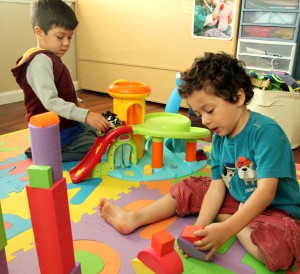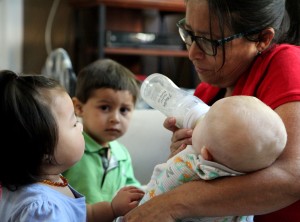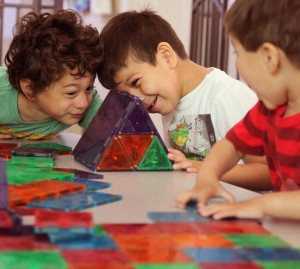

What are the benefits of mixed-age childcare? On the surface, it might seem that children would benefit most from socialization with their peers, i.e. children of the same age. Children until about the age of three generally prefer to engage in parallel play, in which they play side-by-side but not necessarily together. When children are in a developmentally similar stage, parallel play is generally the norm and forms the basis of deeper socialization, in which they eventually learn to interact and cooperate with peers.
In a mixed-age group, an interesting dynamic quickly develops: children learn to help and be helped by other children. Whereas a 2 year old may not show much interest in playing with a peer, the same child may show a strong interest in babies and begin to echo the behavior of the adult caregivers around them: picking up a dropped pacifier, offering a baby a bottle, and so on. This behavior can frequently been seen in sibling pairs, and is a wonderful tool for growing the capacity for empathy in your child. When children are paired with other children in different developmental stages, their own individual abilities become clear, and they begin to see the ways in which they can contribute to a group. Older children learn to lead by example, modeling good behavior and using their more advanced skills to help those around them. Younger children perceive challenges positively, helping them to grow and mature as they grow older.

Tiny Toes offers peer-age socialization through our preschool programs, with the benefits of mixed-age childcare to increase the positive effects of socialization with children and non-family caregivers. Our curriculum is designed to include developmentally appropriate variations for all age groups, where each child can work at their own pace. We love the way in which a mixed-age group helps foster interaction, develop confidence and gain self-esteem from the contributions they are able to make. To understand out how a mixed-age group can benefit your child, observe them as they observe other children around them. Point out positive traits and verbalize them with your child, asking your child to model a similar behavior: “Look how much that baby loves her peas! What looks good on your plate?” “Check out that beautiful picture they are drawing! Can you use your favorite color to color this duck?” and so on. When your child can pick up on the cues of others to act in an appropriate manner, this is socialization at it’s finest!

Leave a Reply